Min Cao
Facial-R1: Aligning Reasoning and Recognition for Facial Emotion Analysis
Nov 13, 2025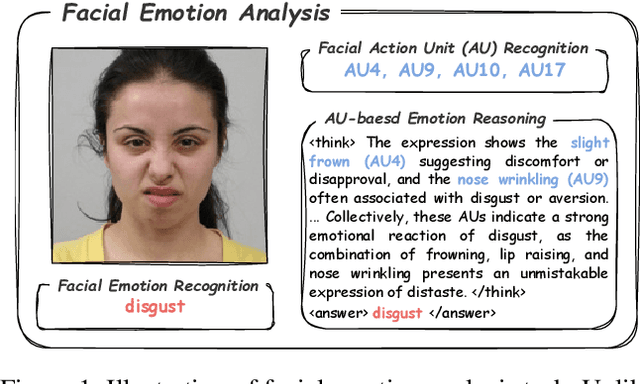
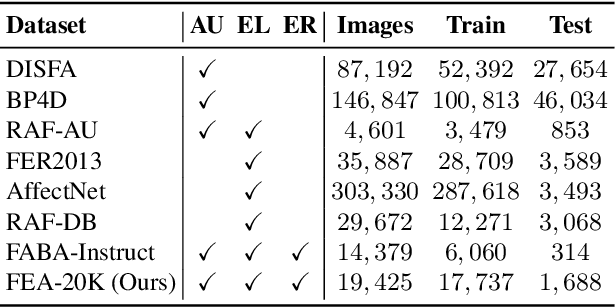
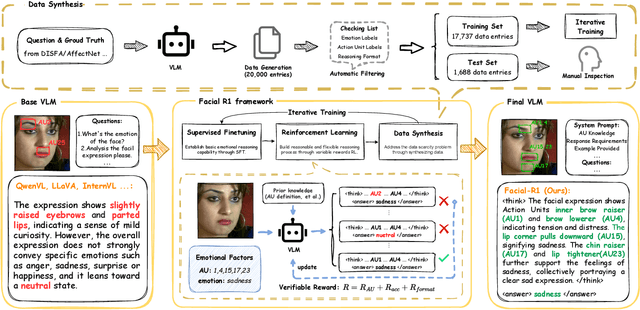
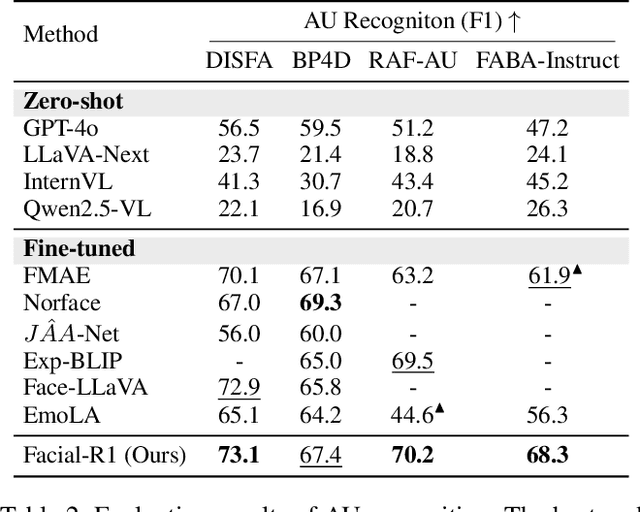
Abstract:Facial Emotion Analysis (FEA) extends traditional facial emotion recognition by incorporating explainable, fine-grained reasoning. The task integrates three subtasks: emotion recognition, facial Action Unit (AU) recognition, and AU-based emotion reasoning to model affective states jointly. While recent approaches leverage Vision-Language Models (VLMs) and achieve promising results, they face two critical limitations: (1) hallucinated reasoning, where VLMs generate plausible but inaccurate explanations due to insufficient emotion-specific knowledge; and (2) misalignment between emotion reasoning and recognition, caused by fragmented connections between observed facial features and final labels. We propose Facial-R1, a three-stage alignment framework that effectively addresses both challenges with minimal supervision. First, we employ instruction fine-tuning to establish basic emotional reasoning capability. Second, we introduce reinforcement training guided by emotion and AU labels as reward signals, which explicitly aligns the generated reasoning process with the predicted emotion. Third, we design a data synthesis pipeline that iteratively leverages the prior stages to expand the training dataset, enabling scalable self-improvement of the model. Built upon this framework, we introduce FEA-20K, a benchmark dataset comprising 17,737 training and 1,688 test samples with fine-grained emotion analysis annotations. Extensive experiments across eight standard benchmarks demonstrate that Facial-R1 achieves state-of-the-art performance in FEA, with strong generalization and robust interpretability.
Text-based Aerial-Ground Person Retrieval
Nov 11, 2025Abstract:This work introduces Text-based Aerial-Ground Person Retrieval (TAG-PR), which aims to retrieve person images from heterogeneous aerial and ground views with textual descriptions. Unlike traditional Text-based Person Retrieval (T-PR), which focuses solely on ground-view images, TAG-PR introduces greater practical significance and presents unique challenges due to the large viewpoint discrepancy across images. To support this task, we contribute: (1) TAG-PEDES dataset, constructed from public benchmarks with automatically generated textual descriptions, enhanced by a diversified text generation paradigm to ensure robustness under view heterogeneity; and (2) TAG-CLIP, a novel retrieval framework that addresses view heterogeneity through a hierarchically-routed mixture of experts module to learn view-specific and view-agnostic features and a viewpoint decoupling strategy to decouple view-specific features for better cross-modal alignment. We evaluate the effectiveness of TAG-CLIP on both the proposed TAG-PEDES dataset and existing T-PR benchmarks. The dataset and code are available at https://github.com/Flame-Chasers/TAG-PR.
SA-Person: Text-Based Person Retrieval with Scene-aware Re-ranking
May 30, 2025Abstract:Text-based person retrieval aims to identify a target individual from a gallery of images based on a natural language description. It presents a significant challenge due to the complexity of real-world scenes and the ambiguity of appearance-related descriptions. Existing methods primarily emphasize appearance-based cross-modal retrieval, often neglecting the contextual information embedded within the scene, which can offer valuable complementary insights for retrieval. To address this, we introduce SCENEPERSON-13W, a large-scale dataset featuring over 100,000 scenes with rich annotations covering both pedestrian appearance and environmental cues. Based on this, we propose SA-Person, a two-stage retrieval framework. In the first stage, it performs discriminative appearance grounding by aligning textual cues with pedestrian-specific regions. In the second stage, it introduces SceneRanker, a training-free, scene-aware re-ranking method leveraging multimodal large language models to jointly reason over pedestrian appearance and the global scene context. Experiments on SCENEPERSON-13W validate the effectiveness of our framework in challenging scene-level retrieval scenarios. The code and dataset will be made publicly available.
MAIR: A Massive Benchmark for Evaluating Instructed Retrieval
Oct 14, 2024



Abstract:Recent information retrieval (IR) models are pre-trained and instruction-tuned on massive datasets and tasks, enabling them to perform well on a wide range of tasks and potentially generalize to unseen tasks with instructions. However, existing IR benchmarks focus on a limited scope of tasks, making them insufficient for evaluating the latest IR models. In this paper, we propose MAIR (Massive Instructed Retrieval Benchmark), a heterogeneous IR benchmark that includes 126 distinct IR tasks across 6 domains, collected from existing datasets. We benchmark state-of-the-art instruction-tuned text embedding models and re-ranking models. Our experiments reveal that instruction-tuned models generally achieve superior performance compared to non-instruction-tuned models on MAIR. Additionally, our results suggest that current instruction-tuned text embedding models and re-ranking models still lack effectiveness in specific long-tail tasks. MAIR is publicly available at https://github.com/sunnweiwei/Mair.
Semi-supervised Text-based Person Search
Apr 28, 2024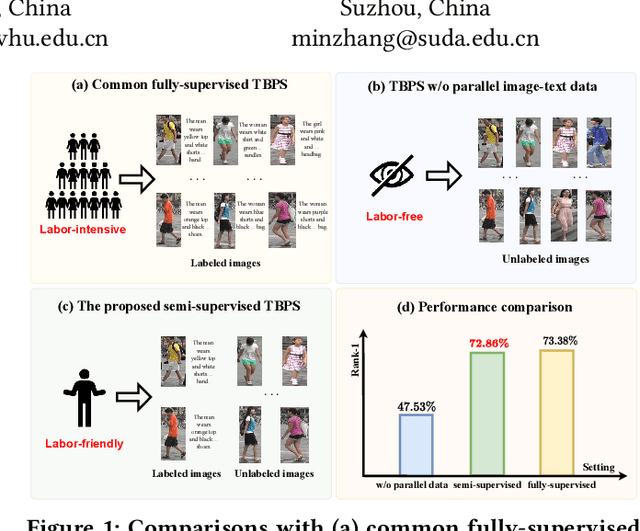

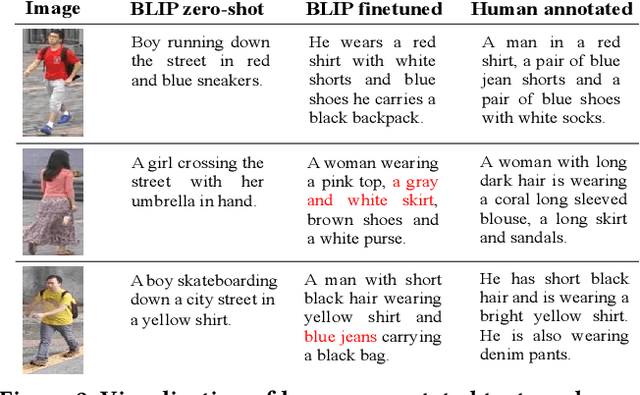
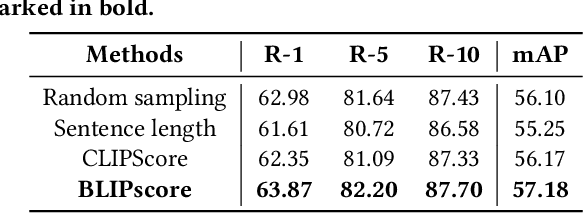
Abstract:Text-based person search (TBPS) aims to retrieve images of a specific person from a large image gallery based on a natural language description. Existing methods rely on massive annotated image-text data to achieve satisfactory performance in fully-supervised learning. It poses a significant challenge in practice, as acquiring person images from surveillance videos is relatively easy, while obtaining annotated texts is challenging. The paper undertakes a pioneering initiative to explore TBPS under the semi-supervised setting, where only a limited number of person images are annotated with textual descriptions while the majority of images lack annotations. We present a two-stage basic solution based on generation-then-retrieval for semi-supervised TBPS. The generation stage enriches annotated data by applying an image captioning model to generate pseudo-texts for unannotated images. Later, the retrieval stage performs fully-supervised retrieval learning using the augmented data. Significantly, considering the noise interference of the pseudo-texts on retrieval learning, we propose a noise-robust retrieval framework that enhances the ability of the retrieval model to handle noisy data. The framework integrates two key strategies: Hybrid Patch-Channel Masking (PC-Mask) to refine the model architecture, and Noise-Guided Progressive Training (NP-Train) to enhance the training process. PC-Mask performs masking on the input data at both the patch-level and the channel-level to prevent overfitting noisy supervision. NP-Train introduces a progressive training schedule based on the noise level of pseudo-texts to facilitate noise-robust learning. Extensive experiments on multiple TBPS benchmarks show that the proposed framework achieves promising performance under the semi-supervised setting.
An Empirical Study of Frame Selection for Text-to-Video Retrieval
Nov 01, 2023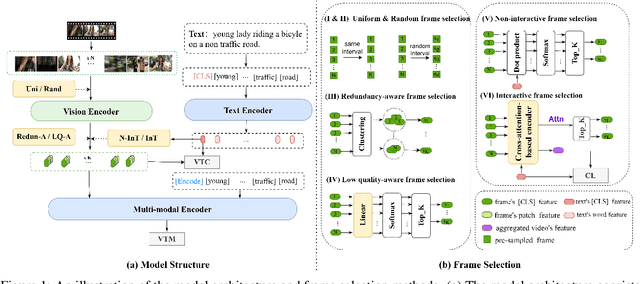
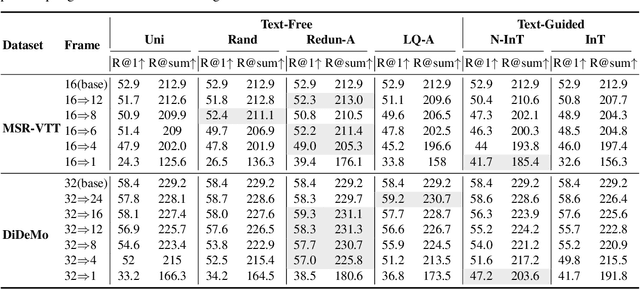


Abstract:Text-to-video retrieval (TVR) aims to find the most relevant video in a large video gallery given a query text. The intricate and abundant context of the video challenges the performance and efficiency of TVR. To handle the serialized video contexts, existing methods typically select a subset of frames within a video to represent the video content for TVR. How to select the most representative frames is a crucial issue, whereby the selected frames are required to not only retain the semantic information of the video but also promote retrieval efficiency by excluding temporally redundant frames. In this paper, we make the first empirical study of frame selection for TVR. We systemically classify existing frame selection methods into text-free and text-guided ones, under which we detailedly analyze six different frame selections in terms of effectiveness and efficiency. Among them, two frame selections are first developed in this paper. According to the comprehensive analysis on multiple TVR benchmarks, we empirically conclude that the TVR with proper frame selections can significantly improve the retrieval efficiency without sacrificing the retrieval performance.
REVO-LION: Evaluating and Refining Vision-Language Instruction Tuning Datasets
Oct 10, 2023Abstract:There is an emerging line of research on multimodal instruction tuning, and a line of benchmarks have been proposed for evaluating these models recently. Instead of evaluating the models directly, in this paper we try to evaluate the Vision-Language Instruction-Tuning (VLIT) datasets themselves and further seek the way of building a dataset for developing an all-powerful VLIT model, which we believe could also be of utility for establishing a grounded protocol for benchmarking VLIT models. For effective analysis of VLIT datasets that remains an open question, we propose a tune-cross-evaluation paradigm: tuning on one dataset and evaluating on the others in turn. For each single tune-evaluation experiment set, we define the Meta Quality (MQ) as the mean score measured by a series of caption metrics including BLEU, METEOR, and ROUGE-L to quantify the quality of a certain dataset or a sample. On this basis, to evaluate the comprehensiveness of a dataset, we develop the Dataset Quality (DQ) covering all tune-evaluation sets. To lay the foundation for building a comprehensive dataset and developing an all-powerful model for practical applications, we further define the Sample Quality (SQ) to quantify the all-sided quality of each sample. Extensive experiments validate the rationality of the proposed evaluation paradigm. Based on the holistic evaluation, we build a new dataset, REVO-LION (REfining VisiOn-Language InstructiOn tuNing), by collecting samples with higher SQ from each dataset. With only half of the full data, the model trained on REVO-LION can achieve performance comparable to simply adding all VLIT datasets up. In addition to developing an all-powerful model, REVO-LION also includes an evaluation set, which is expected to serve as a convenient evaluation benchmark for future research.
Unpaired Multi-domain Attribute Translation of 3D Facial Shapes with a Square and Symmetric Geometric Map
Aug 25, 2023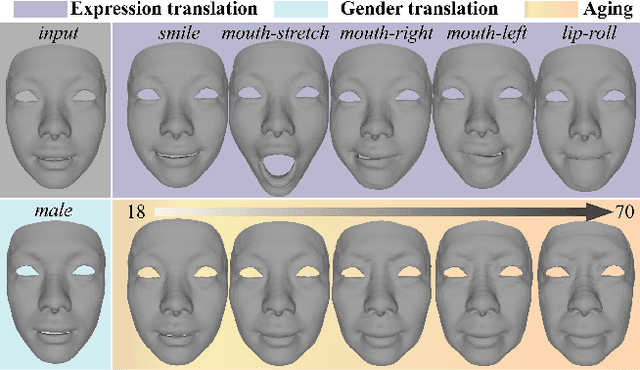


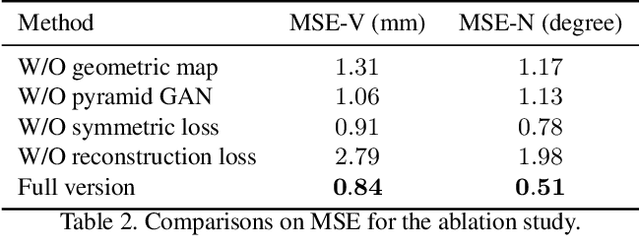
Abstract:While impressive progress has recently been made in image-oriented facial attribute translation, shape-oriented 3D facial attribute translation remains an unsolved issue. This is primarily limited by the lack of 3D generative models and ineffective usage of 3D facial data. We propose a learning framework for 3D facial attribute translation to relieve these limitations. Firstly, we customize a novel geometric map for 3D shape representation and embed it in an end-to-end generative adversarial network. The geometric map represents 3D shapes symmetrically on a square image grid, while preserving the neighboring relationship of 3D vertices in a local least-square sense. This enables effective learning for the latent representation of data with different attributes. Secondly, we employ a unified and unpaired learning framework for multi-domain attribute translation. It not only makes effective usage of data correlation from multiple domains, but also mitigates the constraint for hardly accessible paired data. Finally, we propose a hierarchical architecture for the discriminator to guarantee robust results against both global and local artifacts. We conduct extensive experiments to demonstrate the advantage of the proposed framework over the state-of-the-art in generating high-fidelity facial shapes. Given an input 3D facial shape, the proposed framework is able to synthesize novel shapes of different attributes, which covers some downstream applications, such as expression transfer, gender translation, and aging. Code at https://github.com/NaughtyZZ/3D_facial_shape_attribute_translation_ssgmap.
An Empirical Study of CLIP for Text-based Person Search
Aug 19, 2023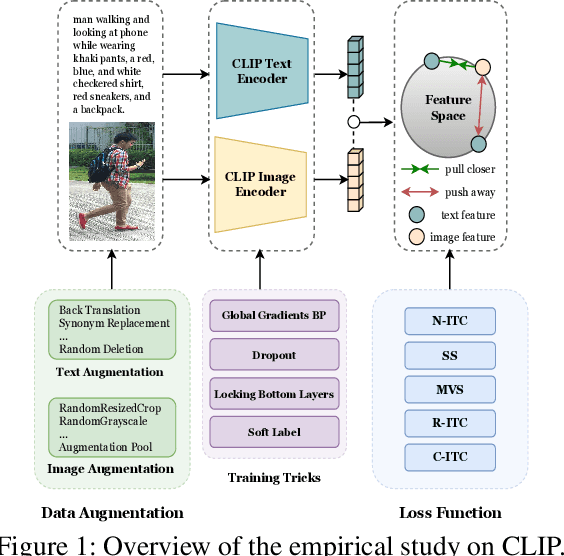
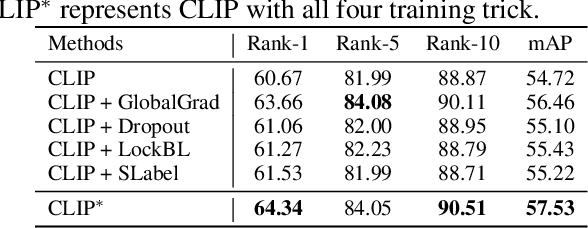
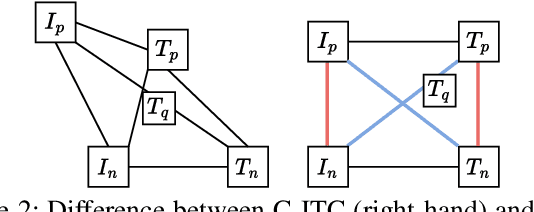
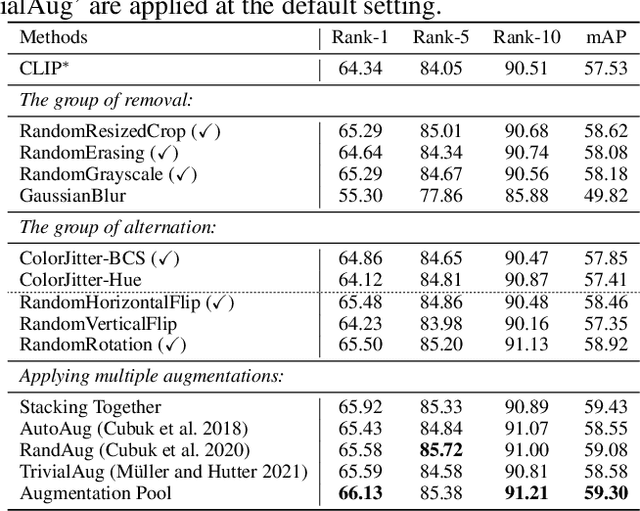
Abstract:Text-based Person Search (TBPS) aims to retrieve the person images using natural language descriptions. Recently, Contrastive Language Image Pretraining (CLIP), a universal large cross-modal vision-language pre-training model, has remarkably performed over various cross-modal downstream tasks due to its powerful cross-modal semantic learning capacity. TPBS, as a fine-grained cross-modal retrieval task, is also facing the rise of research on the CLIP-based TBPS. In order to explore the potential of the visual-language pre-training model for downstream TBPS tasks, this paper makes the first attempt to conduct a comprehensive empirical study of CLIP for TBPS and thus contribute a straightforward, incremental, yet strong TBPS-CLIP baseline to the TBPS community. We revisit critical design considerations under CLIP, including data augmentation and loss function. The model, with the aforementioned designs and practical training tricks, can attain satisfactory performance without any sophisticated modules. Also, we conduct the probing experiments of TBPS-CLIP in model generalization and model compression, demonstrating the effectiveness of TBPS-CLIP from various aspects. This work is expected to provide empirical insights and highlight future CLIP-based TBPS research.
RaSa: Relation and Sensitivity Aware Representation Learning for Text-based Person Search
May 23, 2023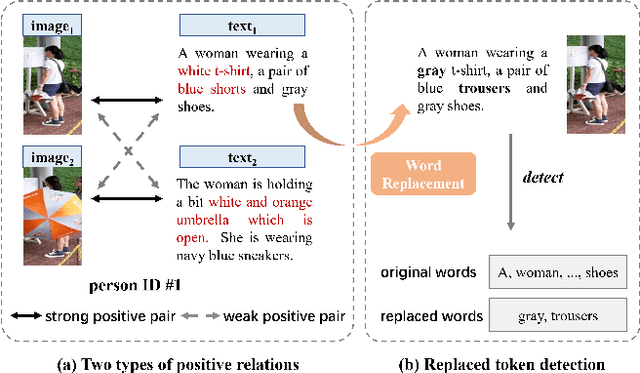
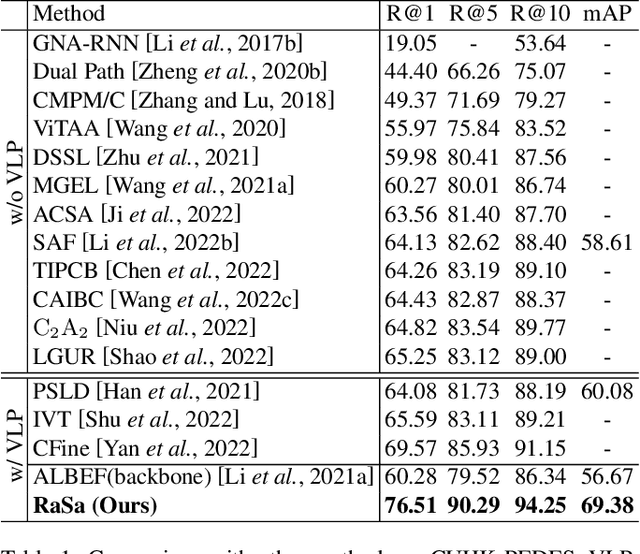
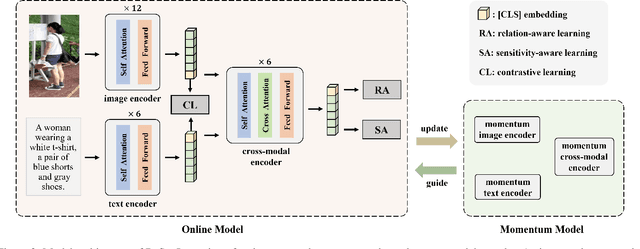
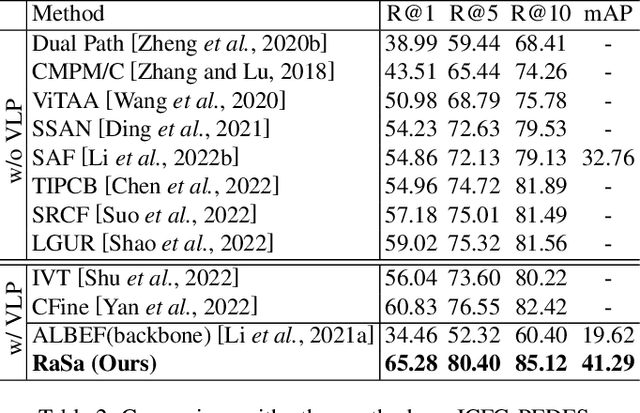
Abstract:Text-based person search aims to retrieve the specified person images given a textual description. The key to tackling such a challenging task is to learn powerful multi-modal representations. Towards this, we propose a Relation and Sensitivity aware representation learning method (RaSa), including two novel tasks: Relation-Aware learning (RA) and Sensitivity-Aware learning (SA). For one thing, existing methods cluster representations of all positive pairs without distinction and overlook the noise problem caused by the weak positive pairs where the text and the paired image have noise correspondences, thus leading to overfitting learning. RA offsets the overfitting risk by introducing a novel positive relation detection task (i.e., learning to distinguish strong and weak positive pairs). For another thing, learning invariant representation under data augmentation (i.e., being insensitive to some transformations) is a general practice for improving representation's robustness in existing methods. Beyond that, we encourage the representation to perceive the sensitive transformation by SA (i.e., learning to detect the replaced words), thus promoting the representation's robustness. Experiments demonstrate that RaSa outperforms existing state-of-the-art methods by 6.94%, 4.45% and 15.35% in terms of Rank@1 on CUHK-PEDES, ICFG-PEDES and RSTPReid datasets, respectively. Code is available at: https://github.com/Flame-Chasers/RaSa.
 Add to Chrome
Add to Chrome Add to Firefox
Add to Firefox Add to Edge
Add to Edge